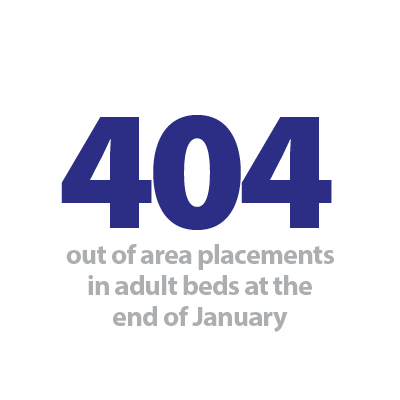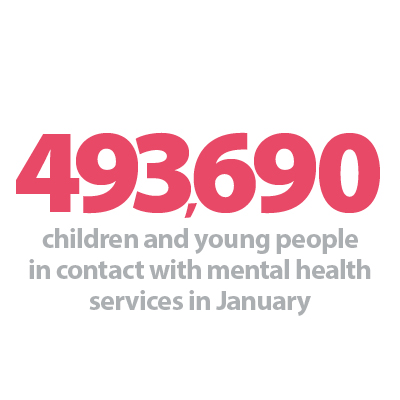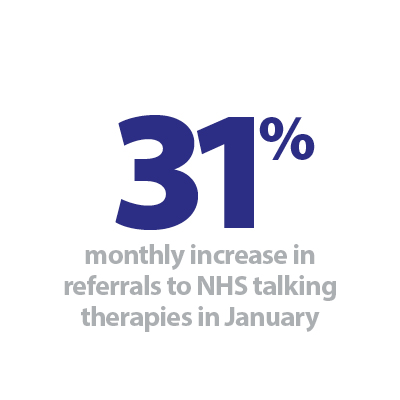


Demand and activity
The latest Mental Health Service Dataset (MHSDS) monthly performance data underscores the growing demand and mounting pressure that NHS trusts continue to face. Our latest explainer blog highlights how, despite increased investment and new services improving access to care, a significant level of unmet need persists. The data shows:
- The number of people in contact with mental health services remains high although slightly below the record high of 2 million seen in December. Compared to pre-pandemic levels, contacts have increased considerably by 43.3%.
- Of these, a record 493,690 were in contact with CYP mental health services in January. Compared to pre-pandemic levels, CYP contacts have more than doubled, increasing by 105%.
- After a fall last month, new referrals to mental health services have risen to 459,550 in January, increasing by over 50,000 since December 2024. Compared to a year ago, referrals are up by 3.5% and are 24.2% higher than pre-pandemic levels.
- In the 12 months leading up to January 2025, 817,310 CYP accessed mental health services with at least one contact - another record high. This is an increase of 5.2% compared to the previous 12-month rolling period and an additional 303,340 contacts since the full set of ambitions for CYP mental health services were set out in the NHS Long Term Plan in January 2019.
- A rise in demand for mental health services means that more patients are receiving care far from their homes and families. At the end of January 2025, there were 404 out of area placements (OAPs) in adult acute beds, which is eight more OAPs than the month before, and 12 more OAPs compared to the previous year.
Learning disability and autism
- 293,330 individuals were in contact with learning disability and autism (LDA) services in January 2025 – a record high. This is an increase of 13% compared to last year and remains 2.3 times higher than pre-pandemic levels (see figure 9).
- There were 2,055 learning disabilities and/or autism inpatients at the end of February 2025. Half of these (50%) had a total length of stay of two years or more.
Figure 9
Number of patients in contact with learning disabilities services

Community mental health
Community mental health services continue to face growing pressures, with waiting lists increasing and many individuals experiencing delays in accessing care. Our latest submission to the Health and Social Care Committee's inquiry into community mental health services outlines key challenges and recommendations to ensure these services can meet rising demand effectively. The most recent community mental health data shows:
- Between November 2024 and January 2025, 195,010 CYP accessed support through NHS-funded mental health services, 10.5% higher than the same time a year ago. Median wait times increased to 14 days this month, in line with the three months between August to October 2024.
- During the same period, 378,680 CYP were still waiting for treatment from community mental health services. This is up by 24.1% compared to last year.
- For adults and older adults with serious mental health illness, 124,600 received their second contact with services between November 2024 and January 2025, increasing by 2.8% compared to the three-month period from August to October 2024. The median wait times for adults is 44 days, an increase of two days since the previous three-month period.
- 206,600 adults and older adults with serious mental illness were still waiting for a second contact treatment from community mental health services in the same period, a fall of nearly 10% compared to the previous three-month period.
Intervention-specific performance and waiting times
Eating disorders
Our recent response to a press release highlights the scale of the challenge, responding to new findings from the Royal College of Psychiatrists over planned spending cuts to children's eating disorder services.
Between November 2024 and January 2025, 77.3% of CYP with eating disorders categorised as urgent cases started treatment within one week, down from 81.2% in the previous three-month period. 77.9% of routine cases started treatment within four weeks, in line with the previous three-month period. Both missed their respective 95% targets.
Figure 10
Percentage of urgent eating disorder cases seen within one week and routine cases seen within four weeks

NHS Talking Therapies
- There were 163,750 referrals to NHS Talking Therapies in January 2025, up by 31% compared to last month. Compared to a year ago, referrals to services are down by 7.4%, but remain similar to the numbers seen before the pandemic (January 2020).
- Despite the increased demand, the national waiting time standard of 75% continues to be met, with 91% of referrals accessing NHS Talking Therapies within six weeks.
Figure 11
Percentage of referrals accessing NHS talking therapies within six weeks

Urgent and emergency liaison mental health services
- In January 2025, there were 15,210 new referrals to liaison psychiatry teams from A&E with first face to face contact within one hour. This was broadly unchanged from last month and last year.
- Over 162,000 calls were made to NHS 111 'select mental health' option in January, which was introduced to streamline access to mental health support in England. Of these calls, 64.9% were answered, an average of 5,420 per day. This is a 3.6% increase on the previous month and has almost doubled since the service opened in April 2024.